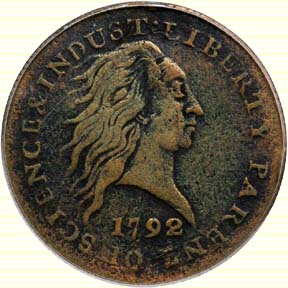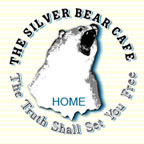United
States of America Money Law
Read the
complete original act
"No State shall
enter into any treaty, alliance, or confederation; grant letters
of marque and reprisal; coin money; emit letters of credit; make
any thing but gold and silver coin a tender in payment of debts; pass
any bill of attainder, ex post facto law, or law impairing the obligation
of contracts, or grant any title of nobility."
Article I, Section 10, CONSTITUTION OF THE
UNITED STATES OF AMERICA
The Coinage Act of
April 2, 1792
(1 Stat. 246)
 
Mint established at the seat of government.
Section I. Be it enacted by the Senate and House
of Representatives of the United States of American in Congress assembled,
and it is hereby enacted and declared, That a mint for the purpose
of a national coinage be, and the same is established, to be situate
and carried on at the seat of the government of the United States .
. .

The US Mint
The place where people brought their gold
and silver to make U.S. dollars. You needed
371.25 grains of pure silver or 24.75 grains
of pure gold to mint one dollar.
(A grain is a monetary unit)
The date of July 18, 1792 marks the
birth of our Philadelphia Mint. Tradition has it that owing to a lack
of bullion, the first coins to be struck at the Mint - silver half
dimes - were wrought from sterling teaspoons donated by President Washington.
It is said that, a year later, Washington contributed "an excellent
copper tea-kettle as well as two pair of tongs" to begin the manufacture
of cents and half cents.
Species of the coins to be struck.
Section 9. And be it further enacted, That there
shall be from time to time struck and coined at the said mint, coins
of gold, silver, and copper, of the following denominations, values
and descriptions, viz.
EAGLES--each to be of the value of ten dollars or
units, and to contain two hundred and forty-seven grains and four eighths
of a grain of pure, or two hundred and seventy grains of standard
gold.
HALF EAGLES--each to be of the value of five dollars,
and to contain one hundred and twenty-three grains and six eighths
of a grain of pure, or one hundred and thirty-five grains of standard
gold.
QUARTER EAGLES--each to be of the value of two dollars
and a half dollar, and to contain sixty-one grains and seven eighths
of a grain of pure, or sixty-seven grains and four eighths of a grain
of standard gold.
DOLLARS OR UNITS--each to be of the value of a Spanish
milled dollar as the same is now current, and to contain three hundred
and seventy-one grains and four sixteenth parts of a grain
of pure, or four hundred and sixteen grains of standard silver.
HALF DOLLARS--each to be of half the value of the
dollar or unit, and to contain one hundred and eighty-five grains
and ten sixteenth parts of a grain of pure, or two hundred and eight
grains of standard silver.
QUARTER DOLLAR--each to be of one fourth the value
of the dollar or unit, and to contain ninety-two grains and thirteen
sixteenth parts of a grain of pure, or one hundred and four grains
of standard silver.
DISMES--each to be of the value of one tenth of a
dollar or unit, and to contain thirty- seven grains and two sixteenth
parts of a
grain of pure, or forty-one grains and three fifths parts of a grain
of standard silver.
HALF DISMES--each to be of the value of one twentieth
of a dollar, and to contain eighteen grains and nine sixteenth parts
of a grain of pure, or twenty grains and four fifths parts of a grain
of standard silver.
CENTS--each to be of the value of the one hundredth
part of a dollar, and to contain eleven penny-weights of copper.
HALF CENTS--each to be of the value of half a cent,
and to contain five penny-weights and a half a penny-weight of copper.

Minting Machine
Two of these (presses) had arrived from
England on September 21, 1792, supposedly from the Boulton and Watt
Mint at Soho near Birmingham. "These presses were put into operation
in the beginning of October, and were used for striking the half dimes
of which Washington makes mention in his Annual Address to Congress
on the 6th of November, 1792 . ." Sylvester Sage Crosby, The United
States Coinage of 1793. -- Cents and Half Cents. (Boston: Published
by the author, 1897)
Of what devices.
Section 10. And be it further enacted, That, upon
the said coins respectively, there shall be the following devices and
legends, namely: Upon one side of each of the said coins there shall
be an impression emblematic of liberty, with an inscription of the
word Liberty, and the year of the coinage; and upon the reverse of
each of the gold and silver coins there shall be the figure or representation
of an eagle, with this inscription, "UNITED STATES OF AMERICA" and
upon the reverse of each of the copper coins, there shall be an inscription
which shall express the denomination of the piece, namely, cent or
half cent, as the case may require.
Proportional value of gold and silver.
Section 11. And be it further enacted, That the
proportional value of gold and silver in all coins which shall by law
be current as money within the United States, shall be fifteen to one,
according to quantity in weight, of pure gold or pure silver; that
is to say, every fifteen pounds weight of pure silver shall be of equal
value in all payments, with one pound weight of pure gold, and so in
proportion as to any greater or less quantities of the respective metals.
Standard for gold coins, and alloy how to be regulated.
Section 12. And be it further enacted, That the
standard for all gold coins of the United States shall be eleven
parts fine to one part alloy; and accordingly that eleven parts fine
to one part alloy; and accordingly that eleven parts in twelve of the
entire weight of each of the said coins shall consist of pure gold,
and the remaining one twelfth part of alloy; and the said alloy shall
be composed of silver and copper, in such proportions not exceeding
one half silver as shall be found convenient; to be regulated by the
director of the mint, for the time being, with the approbation of the
President of the United States, until further provision shall be made
by law. And to the end that the necessary information may be had in
order to the making of such further provision, it shall be the duty
of the director of the mint, at the expiration of a year commencing
the operations of the said mint, to report to Congress the practice
thereof during the said year, touching the composition of the alloy
of the said gold coins, the reasons for such practice, and the experiments
and observations which shall have been made concerning the effects
of different proportions of silver and copper in the said alloy.
Standard for silver coins--alloy how to be regulated.
Section 13. And be it further enacted, That the standard
for all silver coins of the United States, shall be one thousand four
hundred and eighty-five parts fine to one hundred and seventy-nine
parts alloy; and accordingly that one thousand four hundred and eighty-five
parts in one thousand six hundred and sixty-four parts of the entire
weight of each of the said coins shall consist of pure silver, and
the remaining one hundred and seventy-nine parts of alloy; which alloy
shall be wholly of copper.
Penalty of Death for de-basing the coins.
Section 19. And be it further enacted, That if any
of the gold or silver coins which shall be struck or coined at the
said mint shall be debased or made worse as to the proportion of the
fine gold or fine silver therein contained, or shall be of less weight
or value than the same out to be pursuant to the directions of this
act, through the default or with the connivance of any of the officers
or persons who shall be employed at the said mint, for the purpose
of profit or gain, or otherwise with a fraudulent intent, and if any
of the said officers or persons shall embezzle any of the metals which
shall at any time be committed to their charge for the purpose of being
coined, or any of the coins which shall be struck or coined at the
said mint, every such officer or person who shall commit any or either
of the said offenses, shall be deemed guilty of felony, and shall suffer
death.
Money of account to be expressed in dollars, etc.
Section 20. And be if further enacted, That the money
of account of the United States shall be expressed in dollars, or units,
dimes or tenths, cents or hundredths, and the milles or thousandths,
a dime being the tenth part of a dollar, a cent the hundredth part
of a dollar, a mille the thousandth part of a dollar, and that all
accounts in the public offices and all proceedings in the courts of
the United States shall be kept and had in conformity to this regulation.
 
Read the
complete original act

"The abandonment of the gold standard made
it possible for the welfare statists (government bureaucrats) to use
the banking system as an unlimited expansion of credit. In the absence
of the gold standard, there is no way to protect savings from confiscation
through inflation... Deficit spending is simply a scheme for the "hidden" confiscation
of wealth. Gold stands in the way of this insidious process." Alan
Greenspan
|
